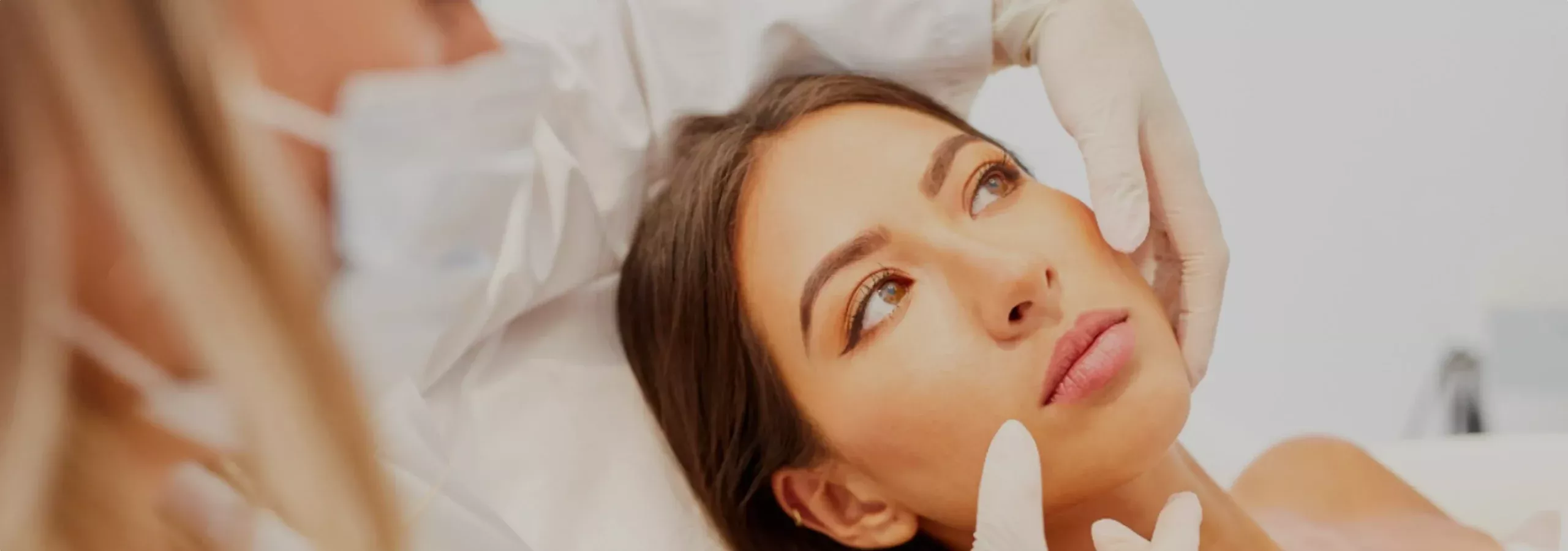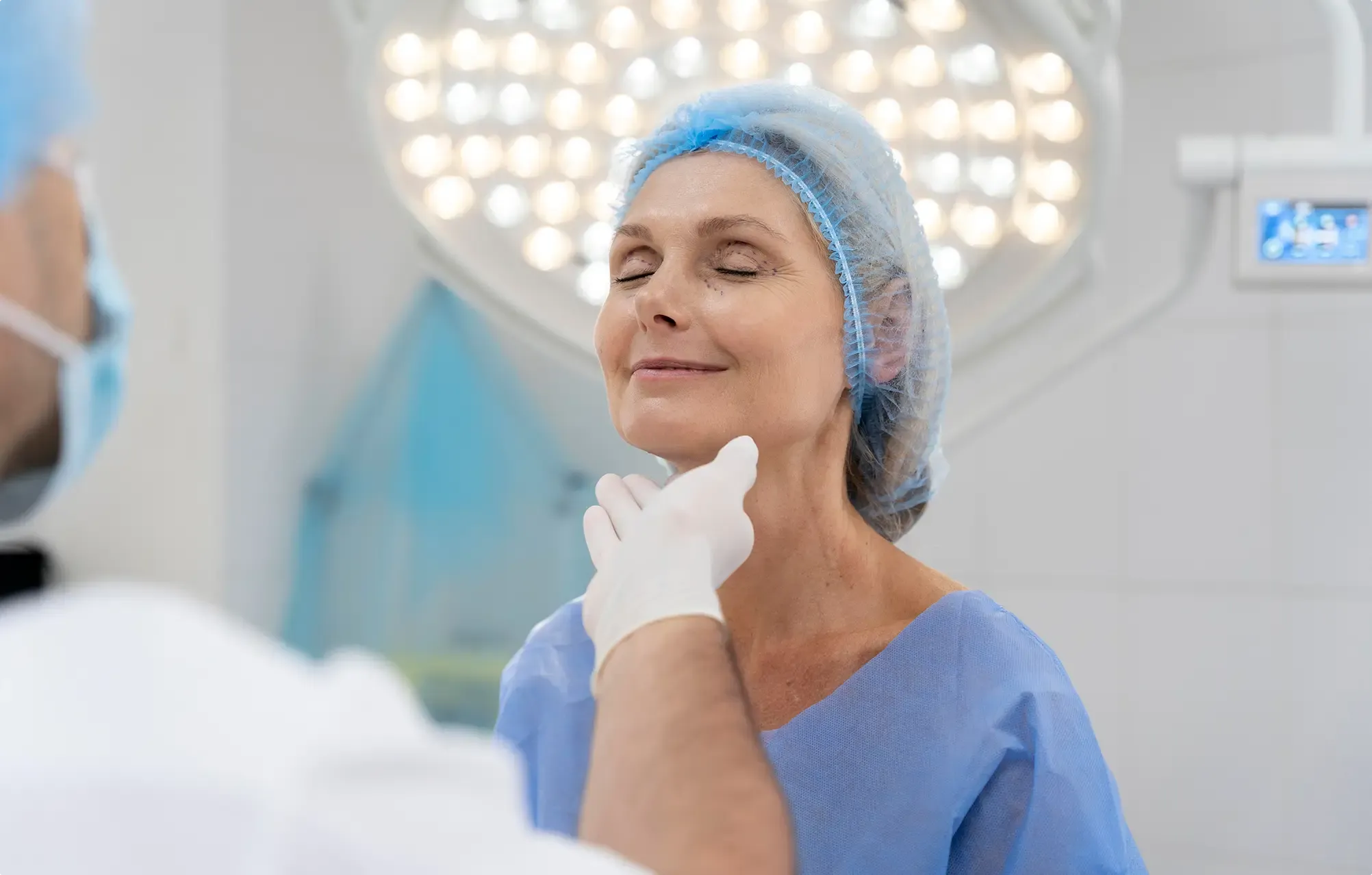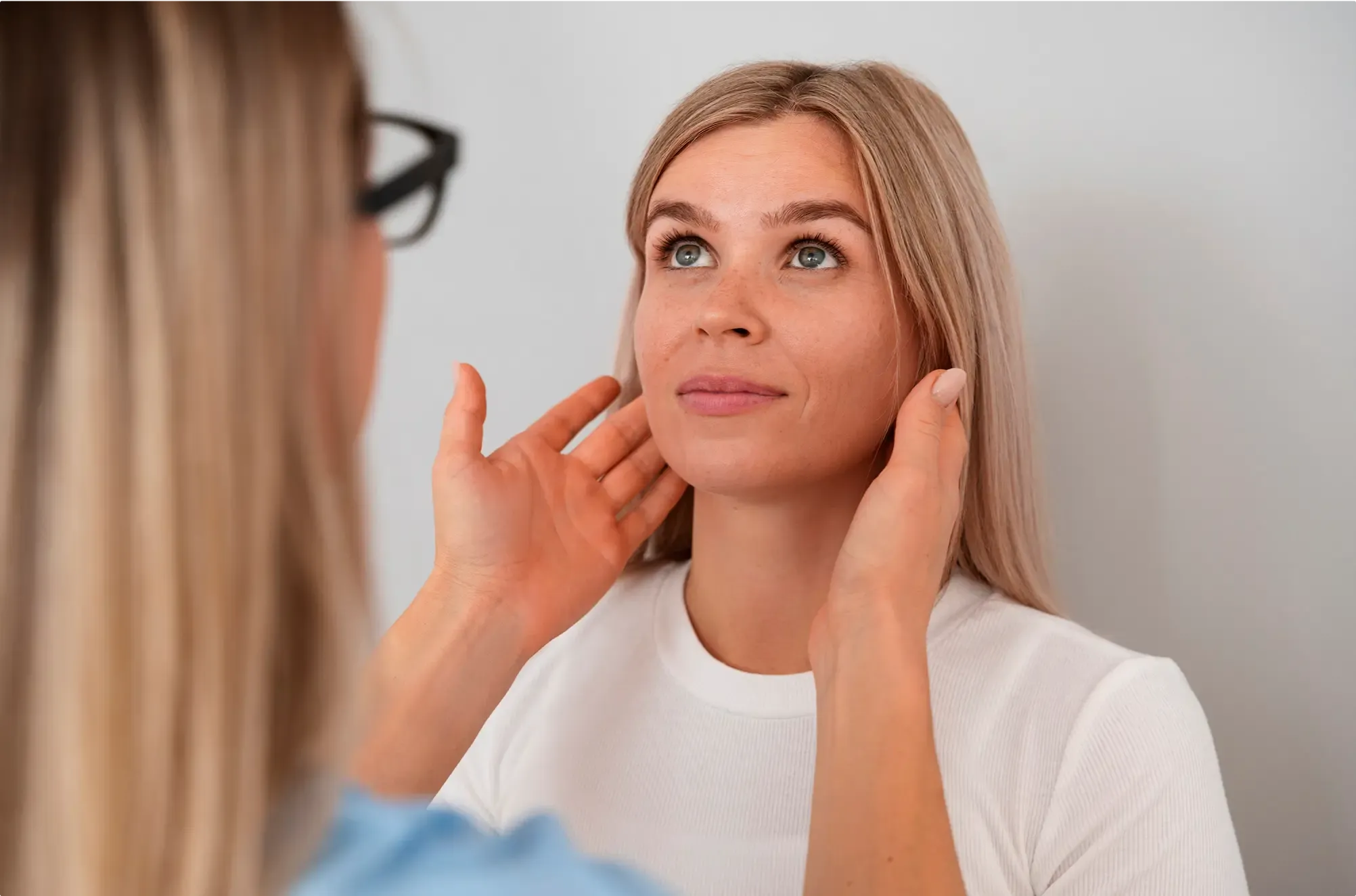
Experience Timeless Beauty with Expert Precision
For residents of the Upper West Side, Mourad NYC offers facelift procedures that blend technical expertise with artistic sensitivity. Rejuvenation isn’t just about looking younger—it’s about revealing a face that mirrors the vitality and energy you carry inside.
Dr. Moustafa Mourad, a double board-certified expert in facial plastic surgery, customizes every lift with precision and care, working to subtly restore structure, reduce signs of aging, and honor your unique facial identity.
Dr. Moustafa Mourad, a double board-certified expert in facial plastic surgery, customizes every lift with precision and care, working to subtly restore structure, reduce signs of aging, and honor your unique facial identity.
What is a Facelift?
Facelift surgery, also known as rhytidectomy, is a cosmetic procedure designed to combat the visible effects of facial aging. Natural aging causes the skin to stretch, facial fat to shift downward, and muscles to lose tone, all contributing to sagging skin, jowls, and wrinkles. A facelift counteracts these effects by elevating facial tissues, tightening underlying muscles, and carefully removing or repositioning skin to restore smoother contours.
Dr. Mourad performs several facelift variations, from comprehensive lifts that refresh the entire face to more targeted mini facelifts. Each surgical plan is tailored to the patient’s facial structure, degree of aging, and desired level of correction.
Dr. Mourad performs several facelift variations, from comprehensive lifts that refresh the entire face to more targeted mini facelifts. Each surgical plan is tailored to the patient’s facial structure, degree of aging, and desired level of correction.

Benefits of a Facelift
A facelift performed at Mourad NYC delivers subtle, age-defying enhancement tailored to your facial structure. Among its most noticeable benefits are:
- Diminishes pronounced wrinkles and folds near the mouth and nose
- Raises sunken cheeks and restores mid-face fullness
- Tightens skin and redefines the jawline, minimizing jowl visibility
- Enhances the chin-to-neck transition for cleaner facial lines
- Reduces the look of fine, sagging skin for a firmer effect
- Reestablishes facial harmony, helping you feel more confident
- Offers long-term improvement that ages naturally with your features
Which Areas Can Be Corrected with a Facelift?
As we age, gravity, sun exposure, and volume loss all contribute to visible facial changes. A facelift helps reverse many of these signs by elevating deep tissues, firming the facial framework, and excising loose or sagging skin. Dr. Mourad’s modern techniques are tailored to your facial anatomy and deliver beautiful, refined results. The areas most often improved include:
Jowls: With age, gravity and skin laxity can lead to a sagging appearance along the jawline, commonly called jowls. Dr. Mourad corrects this by repositioning the descending soft tissues of the lower face to recapture a slimmer, sculpted jawline.
Neck Banding: Visible neck cords form as muscles in the neck begin to separate and pull downward. To correct this, Dr. Mourad unites the platysma muscles beneath the chin to enhance neck definition and smooth vertical lines.
Loose Skin: Facial sagging is often caused by the weakening of foundational structures. Dr. Mourad elevates the deeper tissues first, followed by the gentle removal of excess skin to achieve a lifted, natural result without a stretched appearance.
Fat Under the Chin: Fat deposits in the area below the chin can create a double-chin look, regardless of weight. Dr. Mourad uses precision liposuction to remove fat in this zone, followed by subtle tightening techniques that restore crisp neck contours.
Midface Volume Loss: When the midface deflates, it can lead to a sunken look and accentuate deep smile lines. Dr. Mourad repositions the cheek fat pads to their youthful position. In some cases, implants or fillers are introduced to support facial harmony.
Nasolabial Folds: As cheek tissues descend, nasolabial folds grow more defined. Dr. Mourad’s approach includes lifting the midface vertically to relieve the depth of these lines. He may also recommend injectable fillers for a more comprehensive softening effect.
Jowls: With age, gravity and skin laxity can lead to a sagging appearance along the jawline, commonly called jowls. Dr. Mourad corrects this by repositioning the descending soft tissues of the lower face to recapture a slimmer, sculpted jawline.
Neck Banding: Visible neck cords form as muscles in the neck begin to separate and pull downward. To correct this, Dr. Mourad unites the platysma muscles beneath the chin to enhance neck definition and smooth vertical lines.
Loose Skin: Facial sagging is often caused by the weakening of foundational structures. Dr. Mourad elevates the deeper tissues first, followed by the gentle removal of excess skin to achieve a lifted, natural result without a stretched appearance.
Fat Under the Chin: Fat deposits in the area below the chin can create a double-chin look, regardless of weight. Dr. Mourad uses precision liposuction to remove fat in this zone, followed by subtle tightening techniques that restore crisp neck contours.
Midface Volume Loss: When the midface deflates, it can lead to a sunken look and accentuate deep smile lines. Dr. Mourad repositions the cheek fat pads to their youthful position. In some cases, implants or fillers are introduced to support facial harmony.
Nasolabial Folds: As cheek tissues descend, nasolabial folds grow more defined. Dr. Mourad’s approach includes lifting the midface vertically to relieve the depth of these lines. He may also recommend injectable fillers for a more comprehensive softening effect.
Are You a Candidate for a Facelift in the Upper West Side?
If you feel your face no longer mirrors how youthful or energized you feel inside, a facelift could be worth considering. Ideal candidates often include:
- Men and women with facial sagging or noticeable wrinkle depth
- People dealing with drooping along the jaw or early jowling
- Those with visible neck cords or stubborn fat beneath the chin
- Healthy individuals without chronic conditions that affect healing
- Anyone desiring refined results that don’t look overly surgical
What To Expect During
What To Expect During Your Consultation
Your path to facial enhancement begins with a comprehensive, one-on-one consultation with Dr. Mourad. Lasting around an hour, this appointment focuses on understanding your aesthetic vision while carefully assessing your facial structure. A full medical review will be completed, alongside a hands-on evaluation of your features to determine the safest and most effective treatment approach.
Photographs will be taken from various angles to assist in identifying the changes you’re interested in. Dr. Mourad can also use advanced computer imaging tools to illustrate possible outcomes and spark dialogue about expectations. While these projections are not promises, they offer a helpful visual aid to support your decision-making.
This initial meeting also serves as your opportunity to ask detailed questions, explore procedure types, and learn what each option entails. Dr. Mourad will walk you through your customized surgical plan, post-op care, and expected healing timeline, ensuring you feel well-prepared for the next steps.
Photographs will be taken from various angles to assist in identifying the changes you’re interested in. Dr. Mourad can also use advanced computer imaging tools to illustrate possible outcomes and spark dialogue about expectations. While these projections are not promises, they offer a helpful visual aid to support your decision-making.
This initial meeting also serves as your opportunity to ask detailed questions, explore procedure types, and learn what each option entails. Dr. Mourad will walk you through your customized surgical plan, post-op care, and expected healing timeline, ensuring you feel well-prepared for the next steps.
What To Expect During Your Facelift Procedure
Every facelift performed by Dr. Mourad is highly customized to align with the patient’s unique facial structure and goals. On the day of surgery, you’ll check in at the surgical facility where the clinical team will walk you through the process and keep you comfortable and relaxed.
During the operation, Dr. Mourad carefully elevates and repositions deeper facial layers to create natural, youthful contours. His technique also involves skillful removal of excess skin. With precise bleeding control, there’s no need for post-surgical drains, helping reduce discomfort and speed up recovery.
Once surgery is complete, a soft pressure bandage is applied to secure and support your results. This dressing is typically removed the next morning, either at your follow-up appointment or in your hotel suite. A trained sitter will stay with you overnight to ensure your safety and ease any concerns during the initial recovery phase.
Pain management is generally simple—most patients need only one dose of prescribed medication before switching to over-the-counter options like Tylenol. While neck tightness is expected in the early stages, it serves a positive role in maintaining long-term definition. Bruising and swelling begin to lessen within several days, with most major swelling gone after two weeks.
You’ll return for your first post-op visit within seven days and continue to have regular follow-ups to track your healing progress. It’s important to avoid heavy exercise for three weeks to help ensure optimal results.
During the operation, Dr. Mourad carefully elevates and repositions deeper facial layers to create natural, youthful contours. His technique also involves skillful removal of excess skin. With precise bleeding control, there’s no need for post-surgical drains, helping reduce discomfort and speed up recovery.
Once surgery is complete, a soft pressure bandage is applied to secure and support your results. This dressing is typically removed the next morning, either at your follow-up appointment or in your hotel suite. A trained sitter will stay with you overnight to ensure your safety and ease any concerns during the initial recovery phase.
Pain management is generally simple—most patients need only one dose of prescribed medication before switching to over-the-counter options like Tylenol. While neck tightness is expected in the early stages, it serves a positive role in maintaining long-term definition. Bruising and swelling begin to lessen within several days, with most major swelling gone after two weeks.
You’ll return for your first post-op visit within seven days and continue to have regular follow-ups to track your healing progress. It’s important to avoid heavy exercise for three weeks to help ensure optimal results.

Why Patients from the Upper West Side Trust Dr. Mourad
At Mourad NYC, patients from the Upper West side are drawn to the exceptional combination of artistry, medical expertise, and deeply personalized care. Dr. Mourad has earned a name for himself by delivering facial transformations that are subtle, elegant, and natural-looking—not overdone. His versatility across multiple facelift methods means he can craft a plan uniquely suited to your anatomy and aesthetic vision.
You’ll never feel rushed or overlooked. From your first visit through your recovery, Dr. Mourad provides attentive support and clear guidance at every step. He believes in meaningful results, not quick fixes, and will only recommend surgical options that he believes are in your best interest. His direct involvement throughout your care ensures a smooth experience and outcomes that reflect both skill and integrity.
You’ll never feel rushed or overlooked. From your first visit through your recovery, Dr. Mourad provides attentive support and clear guidance at every step. He believes in meaningful results, not quick fixes, and will only recommend surgical options that he believes are in your best interest. His direct involvement throughout your care ensures a smooth experience and outcomes that reflect both skill and integrity.
What Are the Risks of a Facelift?
Facelift surgery is a safe and proven method for facial rejuvenation, especially in the hands of a qualified expert like Dr. Mourad. Still, as with any medical procedure, there are some risks involved. These may include:
- Infection
- Reactions to anesthesia
- Fluid or blood collection under the skin
- Temporary or permanent nerve changes
- Delayed or poor wound healing
- Visible or uneven scarring
- Hair thinning around incision sites
- Skin color changes
- Irregularities in contour or texture
- Results that do not meet expectations


Transform Your Look
Schedule Your Appointment with Dr. Mourad
If you’re on the Upper West Side and thinking about a facelift that looks refreshed—not artificial—consider scheduling a consultation with Dr. Moustafa Mourad. As a double board-certified facial plastic surgeon, he offers personalized guidance every step of the way, from your first appointment through your final results.
Frequently Asked Questions
Why choose Dr. Mourad over other facial plastic surgery clinics?
Upper West Side residents seeking a refined, youthful appearance often turn to Dr. Mourad for his expertise in facial plastic surgery. As a double board-certified surgeon, Dr. Mourad brings mastery in a range of facelift techniques—from classic to deep plane—to deliver natural-looking results. He’s known for tailoring each procedure to your unique facial structure while supporting you every step of the way with clinical integrity and attention to detail.
How long do the results of a facelift last?
Facelift results can last upwards of 10 years, offering long-term rejuvenation that helps you look more rested and youthful. Thanks to Dr. Mourad’s use of the deep plane facelift method—which lifts underlying tissue rather than just tightening the skin—the improvements tend to be more durable and natural-looking. Although time and gravity still influence your features, the enhancements remain visible far longer than most non-surgical alternatives.
What is the recovery time after a facelift?
Most individuals find they’re comfortable returning to public settings, work, or social gatherings within two to three weeks post-surgery. In the early days, it’s common to experience swelling and discoloration, especially around the jawline and cheeks. These side effects steadily diminish over the first couple of weeks. Full healing and final results continue to evolve over several months, and Dr. Mourad stays actively involved through follow-up visits to ensure optimal recovery.
Which types of facelift surgeries do you perform?
Facial aging doesn’t follow a one-size-fits-all pattern, which is why Dr. Mourad customizes his facelift strategies to suit each patient’s needs. With several advanced techniques available, he can target specific issues like laxity, jowls, or volume loss. Your consultation is the first step—where he’ll evaluate your facial anatomy and recommend a surgical plan built around your personal aesthetic vision.
- Deep Plane Facelift: This highly specialized surgery elevates not only the skin but also the facial muscles and connective tissues beneath. The incisions are carefully placed around the ear and hairline for a seamless finish. In many cases, it includes neck contouring and may involve tightening of deeper structures through a small incision beneath the chin for enhanced definition.
- Mini Facelift: Ideal for patients noticing the first signs of facial aging, this technique improves lower-face sagging with a less invasive approach. It involves limited dissection, resulting in a quicker return to daily activities. The mini facelift effectively restores youthful contours around the chin and jawline.
- Short-Scar Facelift: This variation limits the incision to the area in front of the ear, omitting the extension into the hairline. It works well for individuals with mild drooping but intact neck definition. While scarring is minimal, patient selection is key, as the benefits are not as extensive as full facelift options.
- Endoscopic Facelift: Performed using tiny access points, this technique allows for detailed adjustments beneath the skin with the assistance of a small camera. It’s perfect for targeting early drooping in the cheeks and upper neck with fewer visible scars. Healing is typically faster, though it’s not suitable for more pronounced aging.
- Skin Lift: A straightforward solution for those with surface-level concerns, this procedure removes excess skin without repositioning deeper tissues. It’s often used to enhance prior facelift results or gently rejuvenate the face. Most patients undergo this treatment in-office with local anesthetic and minimal recovery time.
- Lunchtime Lift: Marketed for its quick turnaround, this method uses absorbable threads or light-based tools to deliver a temporary lift. While some may appreciate the convenience, the outcomes are often short-lived and less predictable. Dr. Mourad advises caution, as these techniques can create uneven contours or skin irregularities.
Is a facelift painful?
The recovery is relatively comfortable for most individuals. Pain is usually well managed with prescribed medications for the first day, followed by basic pain relievers like Tylenol. A sensation of tightness in the neck area may occur but is completely normal and even supports healing after a neck lift.
Can other procedures be done at the same time?
Yes—many patients choose to enhance their results by combining their facelift with other facial surgeries such as a nose job, brow lift, or eyelid rejuvenation. Adding facial implants or pairing with treatments like Botox and resurfacing lasers can amplify the overall aesthetic outcome.
Will I have visible scars?
Incisions are strategically placed by Dr. Mourad in areas that are naturally hidden—around the ear contours and within the hairline. These placements, along with his tension-free approach to closure, result in scars that heal well and are difficult to detect over time.
Does insurance cover facelift surgery?
Cosmetic procedures such as facelifts are not covered under typical insurance plans. That said, if the surgery includes functional corrections—for instance, addressing vision issues via eyelid surgery—some reimbursement may be possible. We’ll help navigate this process during your consultation.
Am I too young or too old for a facelift?
Facelift candidacy has more to do with your individual health, facial aging, and desired results than a specific number. Patients in their mid-40s through late 70s often see dramatic improvements when sagging, jowls, or deep folds start to appear.
How does a facelift differ from non-surgical treatments?
Non-surgical methods can temporarily improve skin tone or add plumpness but fall short of lifting underlying facial structures. A facelift repositions skin and muscles at a deeper level, making it the gold standard for comprehensive and long-lasting facial rejuvenation.




